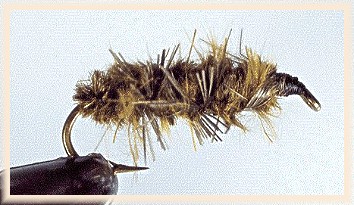|
Someone on the Bulletin Board recently raised
the question: When should we put fish on
the reel, and not hand-line them? It's an
interesting subject.
Several factors influence the decision when to
put fish on the reel: The size of the fish;
Whether we are fishing stillwater or streams;
And, are we fishing from a boat, float tube,
or pontoon boat.
Let's talk "size" first. Other than when the hook
simply pulled out, many of the really large trout
I've lost have been due to one type of foolishness,
or another. And the most common "foolishness" has
been not putting big fish on the reel quickly enough.
When I'm stream fishing, (almost) every fish goes
on the reel immediately. Sometimes, however, it's
not easy to keep them on the reel. There have been
times when I've put large fish on the reel and they've
taken me well into my backing; Then they turned and
charged me so fast I ended up with loops of line in
the river that tangled around snags, rocks, weed
beds...and, at times, my legs. These episodes have
cost me a several memorable trout.
Another factor to be aware of when loose loops of fly
line are lying around in the river, or on shore, it
how sharp some wading cleats can be. I remember buying
a new pair of aluminum stream cleats, and on the first
trip out with them, when the edges were really sharp,
stepped on and cut a nearly new fly line.
If a stream fish is really small, under a foot, I will
sometimes hand-line them, release them, and cast quickly
to other working fish. But for the most part, I can
almost chisel the rule in stone: Stream fish should
be put on the reel as quickly as possible.
If I'm fishing from a boat in stillwater, or on a large
river, I will try and avoid having loops of line lying
around in the bottom of the boat when playing fish. I
will put every fish I hook on the reel at the first
opportunity. I remember the classic Lefty Kreh video
when this legendary angler made every mistake in the
book when fishing salt water from a boat. Lefty lost
his back-cast several times; stepped on his line a
couple times when shooting to large tarpon; and just
plain fouled up constantly during the 30-minute video.
It was hilarious. But more than that...it proved even
the "great one" can make mistakes.
Float tube fishing is another matter. My tubes have
always had stripping aprons. My group of tubers from
southwest Idaho, were the first to install stripping
aprons on our locally manufactured float tubes - sometime
during the mid-50s - and I make good use of them.
Although it is an arbitrary figure, I usually put a
trout on the reel if it appears to be more than
2- or 3-pounds. Smaller fish are almost always
hand-lined when I'm fishing from a float tube.
When hand-lining, the fly rodder is ready, after
releasing his fish, to make a quick roll cast, false
cast once or twice, and shoot his fly to the area where
he expects to find another willing fish. I've watched
newcomers to the sport, put every small fish they hook
on the reel. They then have to take time to strip the
line off the reel before they can make the next cast.
When I'm tubing a lake with fish in the 10- to 18-inch
range, I will sometimes spend an entire day on the water
without ever winding my line back on the reel.
THE UBIQUITOUS BLUEGILL
Another question I recently received via e-mail, had
to do with whether-or-not I would write on any fish
other than trout in my weekly column. Although I do
spend most of my time float tubing for trout, there
are periods of time, particularly during the spring,
when I find more than a little pleasure fishing for
all of our local warm water fish species. I am
particularly fond of the bluegill.
I am fortunate to live in an area with excellent potential
for this little sunfish. I get as much pleasure out of
sitting in my float tube, tossing nymphs, streamers, surface
flies, and poppers, for this most interesting freshwater
fish, as I do for any other fish species. Pound for pound,
the bluegill fights the long rod as strongly as any other
freshwater fish. If bream grew as large as the trout I find
in many of the lakes and reservoirs I fish, I'd probably
give up trout fishing completely. (While most anglers think
of Idaho as a trout state, I've taken bluegill up to 2-pounds,
and our state record is 3 1/2-pounds - only a pound shy of
the all-time record fish).
I once did a newspaper column on the freshwater fish I would
choose if I were limited to just four fish for the rest of
my angling career. I stirred up a bit of controversy in the
circulation area of the newspaper (southern and southwestern
Idaho), by naming the bluegill as my number two fish. For
the record, my four fish are the rainbow trout, the bluegill,
the brown trout and the smallmouth bass.
I wanted to name two trout and two warm water fish (for
diversification). The rainbow and the smallmouth bass are
very much alike in their lifestyles. Both are found in
either streams or lakes; Both take cold water well; both
take surface flies well; and both are extremely strong
and acrobatic fighters.
I like the brown trout better than the two other major
trout species. The cutthroat and brook trout are almost
too easy to fool with flies. Cutts and brookies rarely
jump when hooked, and neither fight as hard as the brown
trout. The only department where they are superior to
the brownie is on the dinner table. And...that's not
really important in my scheme of things (I hope my
cardiologist is not reading this column).
That leaves the bluegill. It is easy to catch, it fights
the rod well, and it is great table fare. Another real
plus, is that the bluegill needs to be thinned out in
most of the lakes and reservoirs I fish, therefor the
limits in Idaho are very liberal (actually there are no
bag limits).
Understanding how to fish for any fish species, is a study
in lifestyles. Where does the fish in question spend most
of its time? At what time of the year does it spawn? Is
it an insect-eater, or a meat-eater? In the case of the
bluegill, anglers often tend to complicate what should be
a simple equation. Just understand the type of aquatic
foods bream key on (almost everything)...and offer them
some fly patterns that "suggest" whatever it is they are
eating at the moment.
I've been a dedicated bluegill angler for more than 30
years. I have two fly boxes filled with flies I've tied
expressly for the species. There's nothing wrong with
bluegill (only) flies. I'm living proof of that. I
have dozens. Both wet and dry.
But before new bream fishermen tie up dozens of bluegill
flies, they should understand that any of the more
productive stillwater trout patterns they have in their
fly boxes, will take bluegill. Until they become "mature"
fish (8-inches and up in the waters I fish), bream are
primarily insect-eaters. Anglers should fish for them
as they would for trout. Some of the best wet flies and
nymphs include: Damsel nymphs, mayfly nymphs, caddis pupas,
midge pupas, leeches, and backswimmers.
When bream are surface feeding, almost any dry fly will
take fish. They feed opportunistically not selectively.
Since a good day on my favorite bluegill pond might be
50 to 100 fish, my preference on a standard dry fly
includes either the Irresistible and the Humpy in
sizes 10 or 12. Both float well and are sturdy
patterns; they will account for a lot of fish
before they wear out.
My favorite bluegill surface pattern is a floater I
call my bluegill spider. I tie the pattern in white,
black, yellow, orange, brown, and green floating rubber
(ant) bodies. Instead of using the more common rubber
legs, I use saddle hackle in the same color as the body.
The best bream fishing is during the spawn. Males are
guarding nests, and will attack anything they feel might
threaten the nests, whether it is on the surface, or down
near the dish-sized nests. After the spawn, the adults
may retreat to deeper water and anglers can fish for
them as they would for large trout. I use streamer
patterns and work them near the bottom.
As I said earlier in this column, bluegill are great
eating. The recipe Vina and I use for our bluegill
is one the late Ted Trueblood gave me many years ago.
At the time we were using various beer batter (type)
recipes to flavor up our fish. Ted said bluegill
(and crappie) are best cooked so as not to "hide"
their delicate flavor. Trueblood told us to simply
dip the fillets in egg batter, roll them on soda
cracker crumbs, and deep fat fry them. I'm still
really not much of a fish eater...unless, that is,
I 've got a freezer full of bluegill fillets.
MARV'S FLY OF THE WEEK
 HORSETHIEF CASED CADDIS
HORSETHIEF CASED CADDIS
HOOK: Mustad 9671, or equivalent, sizes 8 - 14.
THREAD: Black 6/0 prewaxed.
BODY: Underbody of medium olive marabou, overbody
dark-olive chenille. The chenille is wound so that some
of the marabou shows through the wraps.
HACKLE: Dark-olive dyed saddle hackle, palmered,
and clipped short.
HEAD: Black 6/0 prewaxed.
About 25-years ago, I was attempting to "improve" a Woolly
Worm pattern that had been successful at Horsethief Reservoir,
when I came up with the idea of using marabou, or philo, as
an underbody. I thought it created a more natural looking
cased caddis. One of my best fly patterns for Horsethief at
the time had been a dark-olive Woolly Worm, with clipped
dark-olive hackle.
At the time, the lake had a decent population of large caddis
that built cases of twigs and weeds. Often these cases would
be ragged and uneven. The marabou and hackle sticking out
of this chenille pattern offers this uneven appearance.
Although I still use the pattern elsewhere (it has been
especially effective at eastern Idaho's Island Park
servoir over the years), the Horsethief caddis that
caused me to develop the pattern, have been much less
numerous in recent years.
While I usually fish this pattern deep, I have at times
fished it with a floating line. Every now and then we
will find these case-builders floating around dead-drift.
I also tie this design in brown, gray, light olive,
and black. Variegated chenille also works well for
this pattern. ~ Marv
About Marv
Marv Taylor's books, Float-Tubing The West,
The Successful Angler's Journal,
More Fragments of the Puzzle, (Volume I) and More
Fragments of the Puzzle, (Volume II) are all available from
Marv. You can reach Marv by email at
marvtroutman@juno.com or by phone: 208-322-5760.
|



